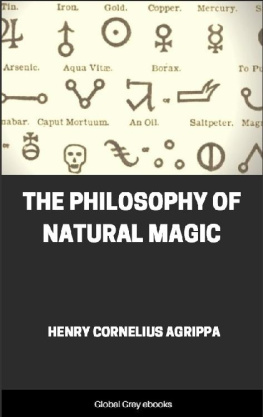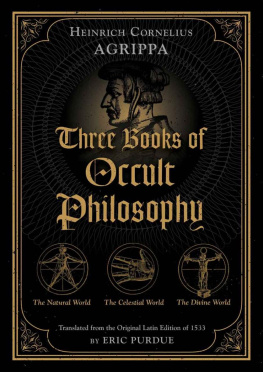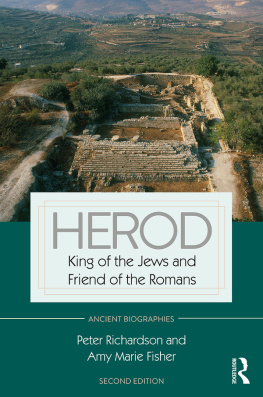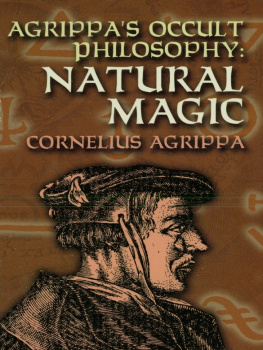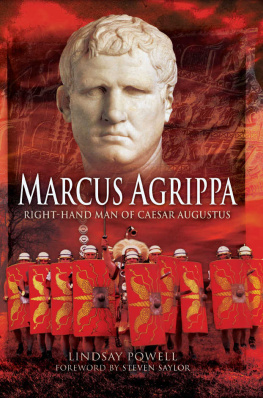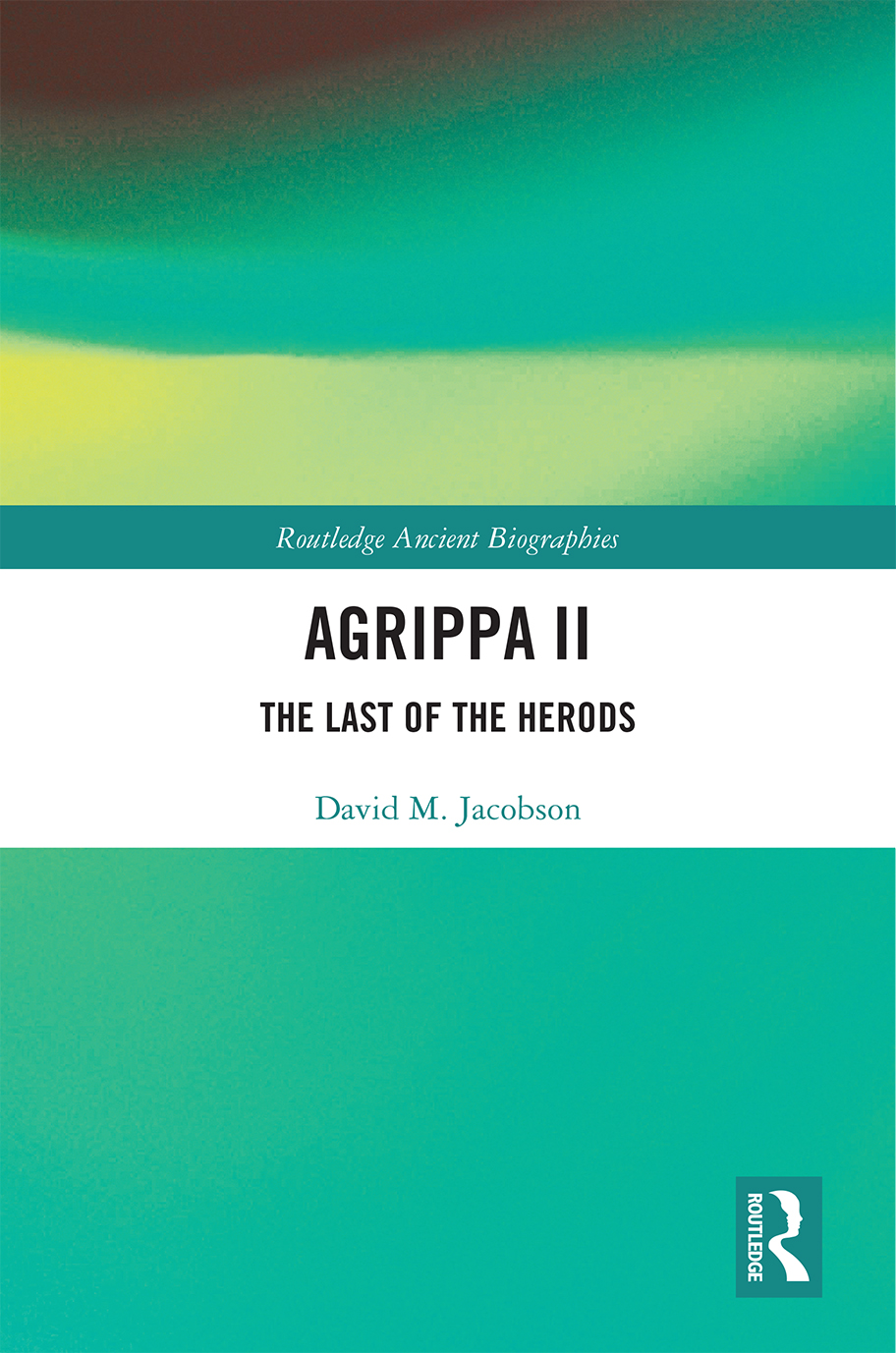Contents
Landmarks
Agrippa II
Agrippa II is the first comprehensive biography of the last descendant of Herod the Great to rule as a client king of Rome. Agrippa was the last king to assume responsibility for the management of the Temple in Jerusalem, and he ultimately saw its destruction in the Judaean-Roman War.
This study documents his life from a childhood spent at the Imperial court in Rome and rise to the position of client king of Rome under Claudius and Nero. It examines his role in the War during which he sided with Rome, and offers fresh insights into his failure to intervene to prevent the destruction of Jerusalem and its Sanctuary, as well as reviewing Agrippas encounter with nascent Christianity through his famous interview with the Apostle Paul. Also addressed is the vexed question of the obscurity into which Agrippa II has fallen, in sharp contrast with his sister Berenice, whose intimate relationship with Titus, the heir to the Roman throne, has fired the imagination of writers through the ages. This study also includes appendices surveying the coins issued in the name of Agrippa II and the inscriptions from his reign.
This volume will appeal to anyone studying Judaean-Roman relations and the Judaean-Roman War, as well as those working more broadly on Roman client kingship, and Romes eastern provinces. It covers topics that continue to attract general interest as well as stirring current scholarly debate.
David M. Jacobson is a Visiting Research Fellow in the Department of Classics at Kings College London, UK, where he also gained his PhD for a thesis entitled The Place of Herods Temple in the Architecture of the Augustan Age. He has published extensively on the history, art, architecture and numismatics of Judaea in the Hellenistic and early Roman Imperial periods, including The Hellenistic Paintings of Marisa (2007), Distant Views of the Holy Land (with Felicity Cobbing) and Antioch and Jerusalem: the Seleucids and Maccabees in Coins (both in 2015).
David F. Graf is Professor in the Department of Religious Studies at the University of Miami, Florida, specialising in the history and archeology of the Graeco-Roman Near East. He is the Director of the Hellenistic Petra Project and Member of the Institute of Advanced Study in Princeton. He has published 150 scholarly articles, is co-editor of the Anchor Bible Dictionary (1992), and author of Rome and Its Arabian Frontier from the Nabataeans to the Saracens (1997).
Routledge Ancient Biographies
Herod, 2nd edition
King of the Jews and Friend of the Romans
Peter Richardson and Amy Marie Fisher
L. Munatius Plancus, 2nd edition
Serving and Surviving in the Roman Revolution
Thomas H. Watkins
Agrippa II
The Last of the Herods
David M. Jacobson
To find out more about this series, visit: https://www.routledge.com/classicalstudies/series/ANCIENTBIOS
First published 2019
by Routledge
2 Park Square, Milton Park, Abingdon, Oxon OX14 4RN
and by Routledge
52 Vanderbilt Avenue, New York, NY 10017
Routledge is an imprint of the Taylor & Francis Group, an informa business
2019 David M. Jacobson
The right of David M. Jacobson to be identified as author of this work has been asserted by him in accordance with sections 77 and 78 of the Copyright, Designs and Patents Act 1988.
All rights reserved. No part of this book may be reprinted or reproduced or utilised in any form or by any electronic, mechanical, or other means, now known or hereafter invented, including photocopying and recording, or in any information storage or retrieval system, without permission in writing from the publishers.
Trademark notice: Product or corporate names may be trademarks or registered trademarks, and are used only for identification and explanation without intent to infringe.
British Library Cataloguing-in-Publication Data
A catalogue record for this book is available from the British Library
Library of Congress Cataloging-in-Publication Data
Names: Jacobson, David M., author.
Title: Agrippa II : the last of the Herods / David M. Jacobson.
Description: Abingdon, Oxon; New York, NY : Routledge, 2019. |
Series: Routledge ancient biographies | Includes bibliographical references and index.
Identifiers: LCCN 2019008084 (print) | LCCN 2019011557 (ebook) |
ISBN 9780429447068 (ebook) | ISBN 9780429823589 (web pdf) |
ISBN 9780429823565 (mobi/kindle) | ISBN 9780429823572 (epub) |
ISBN 9781138331815 (hardback : alk. paper)
Subjects: LCSH: Herod Agrippa II, 27 or
28-94 | Herodian dynasty, 37 B.C.-ca. 94 A.D. |
JewsKings and rulersBiography. | JewsHistory168 B.C.-135
A.D. Classification: LCC DS122.8 (ebook) | LCC DS122.8.J33 2019
(print) | DDC 939.4/3dc23
LC record available at https://lccn.loc.gov/2019008084
ISBN: 978-1-138-33181-5 (hbk)
ISBN: 978-0-429-44706-8 (ebk)
Typeset in Times New Roman
by codeMantra
To the fond memory of my late father, Solly Jacobson, who instilled in me a boundless curiosity.
Family portraits
Herodian building projects in Beirut (Berytus)
Lake Tiberias (Sea of Galilee) and its environs
Bethsaida-Julias and Caesarea Philippi (Paneas), two major cities of Agrippa IIs realm
Gamala/Gamla
A breach in the city wall of Gamala/Gamla during the Roman siege
Numismatic evidence that Agrippa IIs reign came to an end in 94/95 CE
Year 35 = 94/95 CE, based on Agrippas era of 60/61 CE, was the last year coins were issued in the name of the king
Canatha resumed striking its own coins in 94/95 CE, after a break of 45 years, shortly after the city regained its municipal autonomy, i.e., on the death of Agrippa II
Coins of Agrippa II
All the coins illustrated are widely believed to have been minted at Caesarea Philippi (Paneas), but see Burnett 2011, 12425 with find evidence to suggests that Tiberias was a major source of Agrippa IIs coins
This is the only coin issued with the name of Claudia, Neros daughter (died 63 CE), who was deified along with Poppaea (died in 65 CE), on their respective deaths
Graph
List of maps
This accessible and concise biography is the first monograph solely devoted to Agrippa II, the last monarch of Judaea. Herod the Great has long been the sole subject of books. Over the past two decades alone, there have been several monographs about the King of Judaea and his buildings, including those by Peter Richardson (1996), Duane Roller (1998), Sarah Japp (2000), Ehud Netzer (2006), Tamar Landau (2006), Aryeh Kasher (2007), Samuel Rocca (2008), Christian-Georges Schwentzel (2011), Bieke Mahieu (2012) and Geza Vermes (2014). The Herodian dynasty as a whole has been carefully examined by Nikos Kokkinos (2010). Herod Antipas has been the subject of biographies by Harold Hoehner (1980) and Morten Hrning Jensen (2006). Agrippa I has been studied in a book by Daniel Schwartz (1990). Even Agrippa IIs sister Berenice was already in the 17th century the heroine of a play by Racine, simply titled


